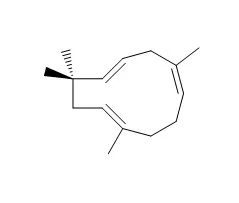| In vitro: |
| An. Real Acad. F., 2010, 76(3):343-56. | | Cytotoxic activity of alpha-humulene and trans-caryophyllene from Salvia officinalis in animal and human tumor cells[Reference: WebLink] | The purpose of the present work is two-fold: the fractionation of Salvia officinalis essential oil and the cytotoxic study of this oil with its fractions "in vitro" tumor cell lines.
METHODS AND RESULTS:
S. officinalis essential oil was obtained by hydrodistillation and fractionated with column chromatography; the essential oil and its fractions were analyzed by gas chromatography (GC) coupled to mass spectrometry (MS). The cytotoxic activity was evaluated in cellular lines of breast cancer MCF-7, colon cancer HCT-116, and murine macrophage RAW264.7 cell lines by the MTT assay Results: the sub-subfraction F1.1.1 of S. officinalis essential oil containing alpha-humulene present highest activity on RAW264.7 and HCT-116 with IC(50) values of 41.9 and 77.3 mu g/ml, respectively. The sub-subfraction F1.2.1 of S. officinalis essential oil with trans-caryophyllene(Alpha-caryophyllene) showed less activity on RAW246.7 and HCT-116 with IC(50) values of 90.5 and 145.8 mu g/ml.
CONCLUSIONS:
This paper suggests that the a-humulene and trans-caryophyllene extracted from S.officinalis essential oil inhibit tumor cell growth. | | Medicines (Basel) . 2017 May 25;4(2):34. | | Anti-Inflammatory, Antioxidant, Antibiotic, and Cytotoxic Activities of Tanacetum vulgare L. Essential Oil and Its Constituents[Pubmed: 28930249] | | Abstract
Background:Tanacetum vulgare L. (Asteraceae) is a perennial herb that has been used to treat multiple ailments. Regional variability of the chemical composition of T. vulgare essential oils is well-known. Despite these regional chemotypes, most relevant studies did not analyze the complete chemical composition of the T. vulgare essential oil and its constituents in relation to their biological activities. Here, we assess the anti-inflammatory, antioxidant, antibacterial, and cytotoxic activities of T. vulgare collected from northern Quebec (Saguenay-Lac-St-Jean), Canada. Methods: Essential oil was extracted from plants by steam distillation and analyzed using GC-FID. Biological activities of essential oil and its main constituents were evaluated in vitro. Results: We identified the major compounds as camphor, borneol, and 1,8-cineole. The oil possesses anti-inflammatory activity inhibiting NO production. It also inhibits intracellular DCFH oxidation induced by tert-butylhydroperoxide. Anti-inflammatory activity of essential oil appears driven mainly by α-humulene while antioxidant activity is provided by α-pinene and caryophyllene oxide. Essential oil from T vulgare was active against both Escherichia coli and Staphylococcus aureus with camphor and caryophyllene oxide responsible for antibacterial activity. Finally, T. vulgare essential oil was slightly cytotoxic against the human healthy cell line WS1 while α-humulene and caryophyllene oxide were moderately cytotoxic against A-549, DLD-1, and WS1. Conclusion: We report, for the first time, links between the specific compounds found in T. vulgare essential oil and anti-inflammatory, antioxidant, antibacterial, and cytotoxic activities. T. vulgare essential oil possesses interesting biological properties. |
|






 Cell. 2018 Jan 11;172(1-2):249-261.e12. doi: 10.1016/j.cell.2017.12.019.IF=36.216(2019)
Cell. 2018 Jan 11;172(1-2):249-261.e12. doi: 10.1016/j.cell.2017.12.019.IF=36.216(2019) Cell Metab. 2020 Mar 3;31(3):534-548.e5. doi: 10.1016/j.cmet.2020.01.002.IF=22.415(2019)
Cell Metab. 2020 Mar 3;31(3):534-548.e5. doi: 10.1016/j.cmet.2020.01.002.IF=22.415(2019) Mol Cell. 2017 Nov 16;68(4):673-685.e6. doi: 10.1016/j.molcel.2017.10.022.IF=14.548(2019)
Mol Cell. 2017 Nov 16;68(4):673-685.e6. doi: 10.1016/j.molcel.2017.10.022.IF=14.548(2019)